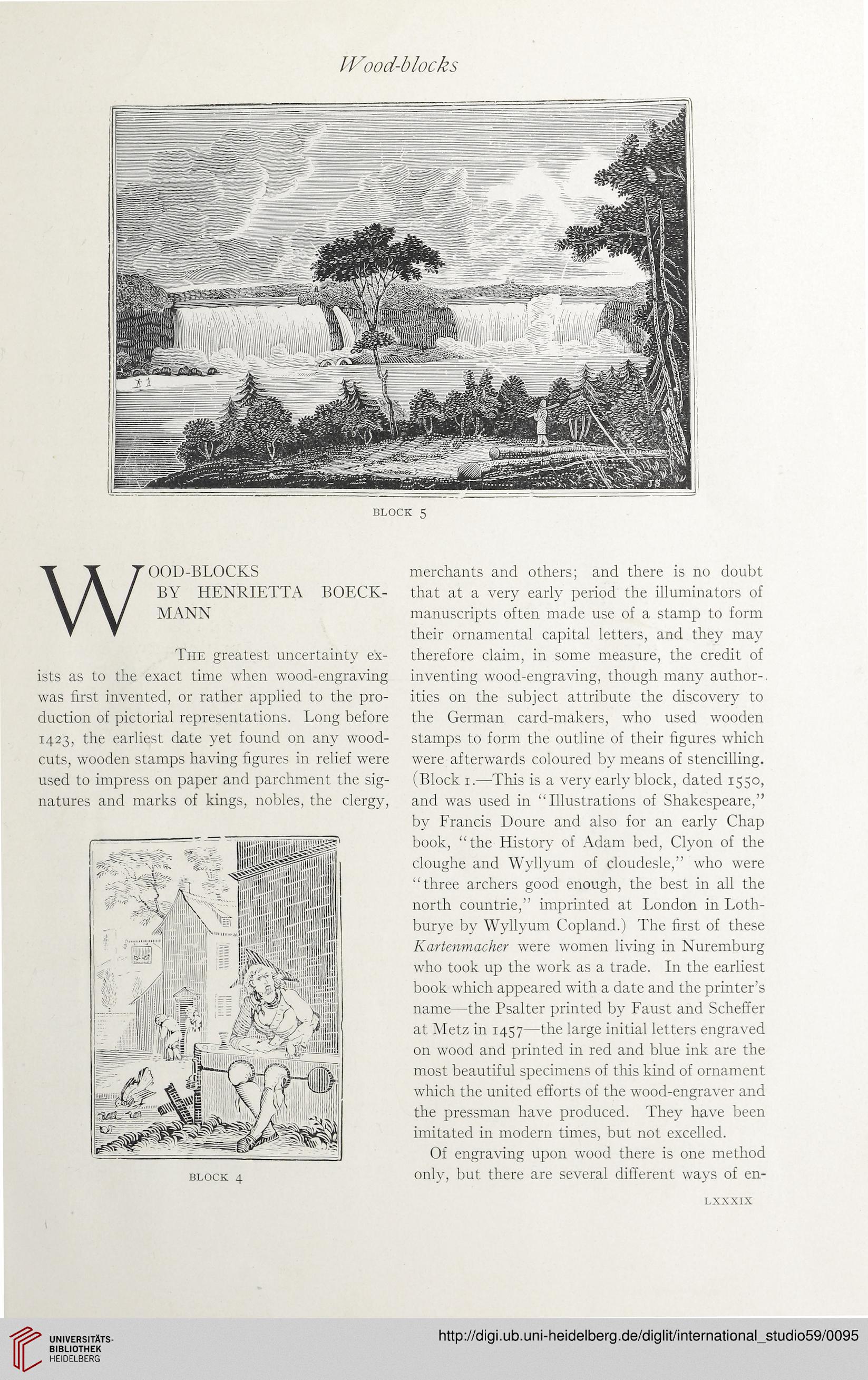Wood-blocks
BLOCK 5
WOOD-BLOCKS
BY HENRIETTA BOECK-
MANN
The greatest uncertainty ex-
ists as to the exact time when wood-engraving
was first invented, or rather applied to the pro-
duction of pictorial representations. Long before
1423, the earliest date yet found on any wood-
cuts, wooden stamps having figures in relief were
used to impress on paper and parchment the sig-
natures and marks of kings, nobles, the clergy,
block 4
merchants and others; and there is no doubt
that at a very early period the illuminators of
manuscripts often made use of a stamp to form
their ornamental capital letters, and they may
therefore claim, in some measure, the credit of
inventing wood-engraving, though many author-,
ities on the subject attribute the discovery to
the German card-makers, who used wooden
stamps to form the outline of their figures which
were afterwards coloured by means of stencilling.
(Block 1.—This is a very early block, dated 1550,
and was used in “Illustrations of Shakespeare,”
by Francis Doure and also for an early Chap
book, “the History of Adam bed, Clyon of the
cloughe and Wyllyum of cloudesle,” who were
“three archers good enough, the best in all the
north countrie,” imprinted at London in Loth-
burye by Wyllyum Copland.) The first of these
Kartenmacher were women living in Nuremburg
who took up the work as a trade. In the earliest
book which appeared with a date and the printer’s
name—the Psalter printed by Faust and Scheffer
at Metz in 1457—the large initial letters engraved
on wood and printed in red and blue ink are the
most beautiful specimens of this kind of ornament
which the united efforts of the wood-engraver and
the pressman have produced. They have been
imitated in modern times, but not excelled.
Of engraving upon wood there is one method
only, but there are several different ways of en-
LXXXIX
BLOCK 5
WOOD-BLOCKS
BY HENRIETTA BOECK-
MANN
The greatest uncertainty ex-
ists as to the exact time when wood-engraving
was first invented, or rather applied to the pro-
duction of pictorial representations. Long before
1423, the earliest date yet found on any wood-
cuts, wooden stamps having figures in relief were
used to impress on paper and parchment the sig-
natures and marks of kings, nobles, the clergy,
block 4
merchants and others; and there is no doubt
that at a very early period the illuminators of
manuscripts often made use of a stamp to form
their ornamental capital letters, and they may
therefore claim, in some measure, the credit of
inventing wood-engraving, though many author-,
ities on the subject attribute the discovery to
the German card-makers, who used wooden
stamps to form the outline of their figures which
were afterwards coloured by means of stencilling.
(Block 1.—This is a very early block, dated 1550,
and was used in “Illustrations of Shakespeare,”
by Francis Doure and also for an early Chap
book, “the History of Adam bed, Clyon of the
cloughe and Wyllyum of cloudesle,” who were
“three archers good enough, the best in all the
north countrie,” imprinted at London in Loth-
burye by Wyllyum Copland.) The first of these
Kartenmacher were women living in Nuremburg
who took up the work as a trade. In the earliest
book which appeared with a date and the printer’s
name—the Psalter printed by Faust and Scheffer
at Metz in 1457—the large initial letters engraved
on wood and printed in red and blue ink are the
most beautiful specimens of this kind of ornament
which the united efforts of the wood-engraver and
the pressman have produced. They have been
imitated in modern times, but not excelled.
Of engraving upon wood there is one method
only, but there are several different ways of en-
LXXXIX




